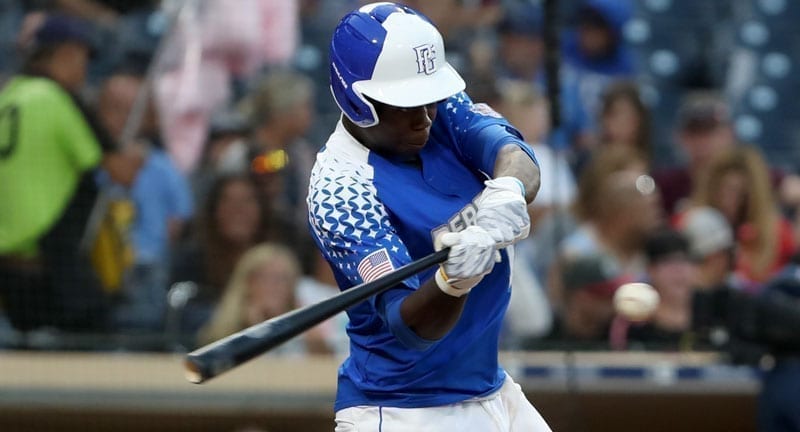Teams are not built on first-round picks alone. Yes, a large portion of the league’s talent comes from the top of the draft, but an all-star team of players could easily be constructed from guys picked from the second round on down. Just to name a few, Cody Bellinger, Marcus Semien, Paul Goldschmidt, Jacob DeGrom, and Shane Bieber.
The success of the Orioles’ future will depend not only on their ability to convert top-5 picks to stars but also on the conversion of later picks to regulars—and the occasional star. They have two very good opportunities to make this happen this year, with picks #30 and #39 in the Comp A and 2nd rounds. So today, we’re going to look at 6 players the Orioles may consider at these picks: Two who would have to fall a little to reach the Orioles at #30, two who comfortably slot into the 30s range, and two players ranked 40th and lower who could get taken at #39. This availability is determined by Baseball America’s rankings, with consideration for those players being discussed determined by their DRAFT Model Score (Details here).
Tanner Burns
Auburn’s answer to Emerson Hancock, Tanner Burns has been a fixture of the Tigers’ rotation since he arrived. For that matter he was more highly regarded than Hancock, going to campus after being the 38th-ranked player in the 2017 Draft according to Baseball America. He’s been all that Auburn could have asked for, putting up a 2.89 ERA, 3.16 BB/9, and 9.64 K/9 in 166 collegiate innings.
Burns comes in with a DRAFT score of 13.15, 20th overall in the model. He has limited walks—adjusted BB of -0.024—and struck out batters at an impressive clip—adjusted K of 0.121. The biggest questions for Burns come in his physicality. He stands only 6’0″ tall, which tends to push players towards the bullpen. The model agrees with those questions, giving him a 77.7% starter percentage. That said, his arsenal is solid and he has the numbers to back it up. This gives him a higher probability of making the majors—98% according to the model—than his ranking suggests. Burns seems like a high-floor solid mid-rotation piece, something that could grow into more if he show the physicality required for a starting role.
Cole Wilcox
You could talk about Austin Wells or J.T. Ginn here, but both come with considerable questions—Wells seems likely to move off catcher lowering his score greatly and Ginn has an injured elbow and is a draft-eligible sophomore. With that in mind, we go to Emerson Hancock’s rotation running mate in Cole Wilcox. Wilcox was the 37th-ranked player in the 2018 Draft, and thus is a draft-eligible sophomore. After a slightly wild Freshman year—5.7 BB/9—Wilcox roared out of the gate with 32-2 K-BB ratio in 23 innings. It’s not sustainable, but Wilcox’s stuff can stand up to some of the best in the country.
Wilcox’s DRAFT score comes in at 10.7, and it could honestly be higher. His walk rate is a little pedestrian—only at -0.003—but definitely brings the strikeouts—0.0977 above expected. However, his walks and time in the bullpen bring his predicted starter percentage down to 60.9%, a number some scouts would agree with. If the walks were a little more under control and that starter percentage went up, Wilcox could easily vault up to a top-20 score.
Wilcox definitely has a few questions with his profile, and we haven’t even mentioned signability. As a draft-eligible sophomore in a year when bonuses aren’t going to be initially paid in full, there’s going to be a strong likelihood that Wilcox goes back to school. It’d likely take top-15 money or better to sign, so Wilcox would have to be a player the Orioles plan several selections around in order to get. That said, in a year he might be a top five pick so stealing him at a top-15 price would be still a bargain.
Jordan Walker
The model loves big high school players with power potential, and Walker has that in spades. 6’5″, 220 pounds, and like Zac Veen it looks like he could comfortably add weight.
Walker’s DRAFT score is 16.05, 15th overall in the class. That said, he does have a few questions around his chances of staying at his listed position of third base. Many scouts think he’s likely to move across the infield to first base, and the model agrees: 25% third base, 15% first base, and a lot of extra uncertainty otherwise. If he moves to primarily first base, his model score drops quickly, requiring the bat to be special.
Walker seems like a player who could be headed to campus—he’s committed to Duke. In a few years, he could be Spencer Torkelson or Kris Bryant from a college stats perspective. If the Orioles believe that he truly is a third baseman, they probably shouldn’t let him get there.
Slade Cecconi
The 30s in this draft is full of high school players who may be tough signs and draft-eligible sophomores, and Slade Cecconi leads the pitchers among that group. Selected by the Orioles in 2018 as a draft-and-follow situation, Cecconi stepped onto Miami’s campus and into the rotation. He looks the part, standing 6’4″-212 pounds—an impressive pitcher’s frame. He limited walks, struck out over a batter an inning, but these numbers didn’t necessarily translate into run prevention.
Cecconi’s DRAFT score is 11.07, slightly ahead of his Miami teammate Chris McMahon. His profile is driven by his adjusted strikeout rate and adjusted walk rate—0.0906 and -0.033 respectively. He doesn’t have the highest starter percentage, coming in at 75.7%, but he has the stuff—upper 90s fastball, 3 secondaries that flash plus—to reach a high ceiling should he stick.
Again, Cecconi is a draft-eligible sophomore. Thus, he will likely be a tough sign in this year’s draft given that he could suddenly find himself a top-10 guy with another successful season. Like Wilcox, he would likely require an extra million plus to get him to sign.
Logan Allen
Logan Allen is a player where evaluation and stats diverge. He struck out nearly 12 batters-per-nine in college while walking 2.2. Even after adjusting for competition, it’s still the highest in the draft. However, he does this working off substandard stuff, at least for his numbers. He works with a low-90s fastball, average-to-plus changeup, and average curve, but all this plays up due to his control and deception. If everything comes together it could be like Shane Bieber in 2018—he of a low-90s fastball, incredible control, and average secondaries out of college.
Allen’s strikeouts drive his DRAFT score up to 13.59, sitting more in line with top-30 pitchers than his Baseball America rank of 56. Again, his incredible strikeout rate—adjusted K rate of 0.1842 above expected—drives this score. He comes in with an expected starting percentage of 74.9%, solid considering his relatively lower ranking.
Allen likely won’t be there at #74, but he almost surely will still be on the board at #39. In that case, he represents an interesting opportunity for the Orioles to save some money for an overslot at #30 while still getting a high DRAFT score sort of player. Depending on who the team is eyeing at #30, Allen could be a major player for the team at #39.
Daniel Cabrera
Depending on how the draft goes, Cabrera could be gone earlier than his #41 Baseball America ranking. The LSU outfielder came to campus after ranking #82 in 2017 and has performed as one would expect. His Junior year got off to a slower start from a power perspective, but scouts still love his ability to hit line drives to all fields.
Cabrera’s DRAFT score is 8.71, 38th overall and in line with his Baseball America rank of 41. The profile is pretty standard for where he sits: adjusted BB at 0.021 above expected, adjusted strikeouts 0.004 above expected, and adjusted ISO 0.071 above expected. The positional model check Cabrera in mostly at a corner outfield spot—55.9%—and scouts tend to agree.
In a normal year, Cabrera would have a very good chance of being available at #39. However, in a year where signability concerns are magnified and college players are going to be more-heavily picked, Cabrera is right on the line where things could go either way. If the Orioles are lucky and have money available, he could be a nice addition to the fold.
***********************
Next week, we’ll look at the Orioles’ final three picks, scouring for value in rounds three through five. Between now and then, if you want to look at player scores and see some of the other options available, you can vising my site to look at the full DRAFT model results.

Orioles Analyst
Dr. Stephen Loftus received his Ph.D. in Statistics from Virginia Tech in 2015 and is an Assistant Professor of Mathematical Sciences at Randolph-Macon College. Prior to that, he worked as an Analyst in Baseball Research and Development for the Tampa Bay Rays, focusing on the Amateur Draft. He formerly wrote at FanGraphs and Beyond the Box Score. As a lifelong fan of the Orioles, he fondly remembers the playoff teams of 1996-97 and prefers to forget constantly impending doom of Jorge Julio, Albert Belle’s contract, and most years between 1998 and 2011.
